An external link is a link from one site which links to another site not on the same domain.
External links stand in contrast with internal links, which are links pointing to a page on the same domain or subdomain.
Having authoritative external links is one of the most important ranking signals of Google's ranking algorithm.
SEO Basics Checklist
A successful SEO strategy starts with the basics. If you are still trying to understand what SEO really means, then it is time for some housekeeping.
By following the below points, you will already be ahead of most law firms online. These suggestions can also be applied to any website that you have or manage, as they are just as important for a law firm as they are for any other type of business.
1) Set up Google Search Console
Google Search Console provides you with a wealth of information about how well your site performs in organic search.
With Google Search Console, you can see the keywords your website ranks for, check where it is in comparison with other websites on these terms and find any errors that might be preventing traffic. You may also submit sitemaps if needed.
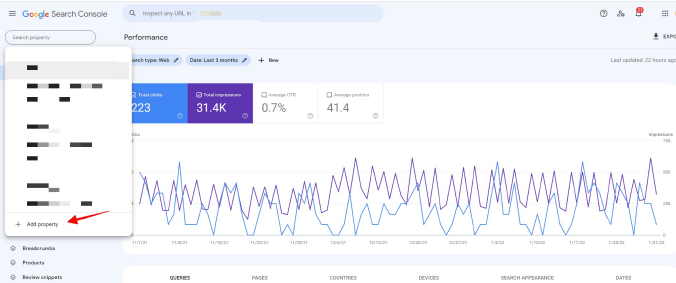
2) Set up Bing Webmaster Tools
Bing is not as popular as Google, but it still gets approximately 1 billion visitors per month. This means it is worth optimizing for.
Bing Webmaster Tools also offer some nifty features like a built-in keyword research tool.
3) Set up and Optimize Google My Business
To make sure your law firm can be found in Google, you need to set up and optimize Google My Business.
Google My Business is a great way to get your law firm seen by potential clients, but it takes time and effort. Fill out every field possible in its entirety, including all locations you serve and areas of law you practice.
Additionally, post on Google My Business regularly and keep your profit up-to-date by updating hours, whether you're taking in-person meetings due to Covid-19, etc.
4) Set up Google Analytics
Google Analytics is the perfect way to get an overview of who's visiting your site and what they're doing there. For example, it provides information on where people are coming from and which pages you might want more attention focused towards in future posts or campaigns.
Connect Google Analytics with Google Search Console and you will be able to see helpful SEO information from inside of your Google Analytics account.
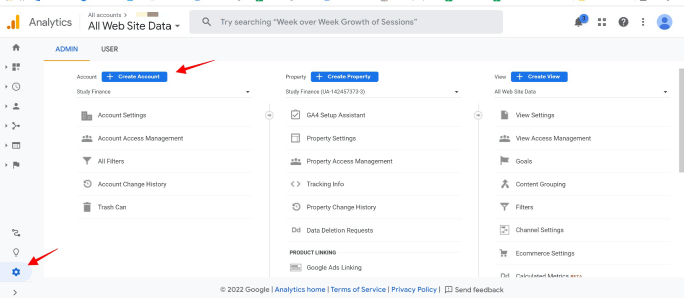
5) Install and Configure an SEO Plugin (If You Are Using WordPress)
You don't want to go without an SEO plugin. If you're using WordPress, then it's important that the site has been optimized for search engines like Google and Bing which will help rank your content higher on Search Engine Results Pages (SERPs).
Yoast SEO is one of the most popular options for beginners who want their sites to rank well in search engines. It's easy, intuitive, and gets the job done with little frustration or need for customization on your end.
Other options include Rank Math and The SEO Framework.
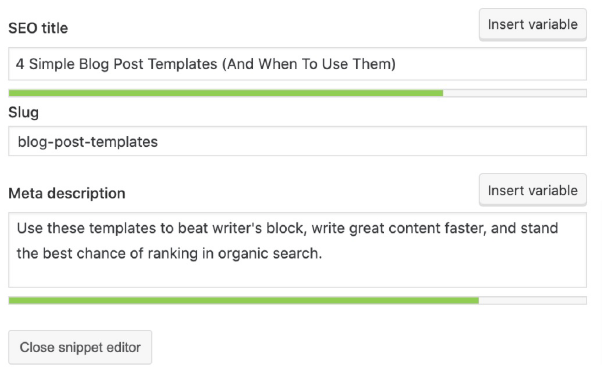
6) Create and Submit a Sitemap
Search engines use sitemaps to decide which pages should be crawled and indexed. A site map lists the main content on your website so that it can get picked up by search engine robots, leading you to higher rankings in SERPs.
Google supports many different sitemap formats, but the most popular is XML. You can usually find your sitemap at https://www.example.com/sitemap.xml.
You will find that generating a sitemap is standard functionality if you are using WordPress.
When you have generated your sitemap, make sure that this is submitted to Google Search Console and Bing Webmaster Tools.
You should also reference your sitemap in your robots.txt file.
Once created, submit the sitemap to Google Search Console:
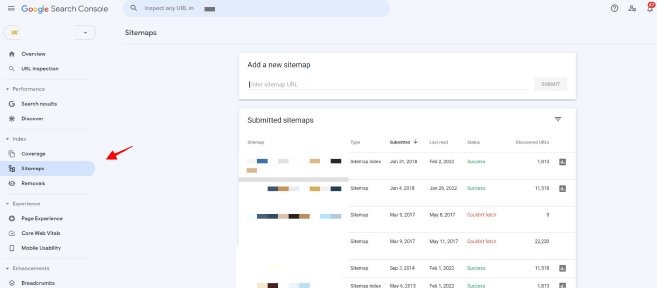
7) Create a Robots.txt File
You need to tell search engines not to index some of your pages or block access to some files, like CSS and JS. You can do this by creating a robots.txt file on your site.
If you're running WordPress, then you can create a robots.txt file in the root directory of your site.
Refer to Google's documentation on how to create a robots.txt file. Additionally, you can create one with a robots.txt generator.
You will likely need to work with a developer in order to set up your robots.txt file.
8) Check Google Search Console for Manual Actions
You may find that your site has been negatively affected by having a manual action imposed upon it.
Manual actions are caused by an attempt at violating or manipulating Google's Webmaster Guidelines, which includes things like user-generated spam, structured data issues, unnatural links, and others.
Most sites won't ever come across this sort of thing, however you should still check for these issues in Google Search Console's manual actions tab.
You will be notified if your site received a manual action. As good practice, it should always be one of the first things that you do when taking over an existing project or working on a new site.

9) Index Your Website
You may be surprised at how often a sudden de-indexing of your site can happen due to developers accidentally leaving noindex tags in place when moving code from staging environments.
Simply start a crawl and if this is blocked, search engines won't be able to crawl or index your site either.
To check if a page is indexed on your website, copy/paste a URL into Google Search Console:

10) Have a Short and Professional Domain Name, Preferably on the .Law TLD
You want to avoid having a domain name that is too long.
Having a domain name that is short and concise improves the memorability of the domain and improves trust. Short and professional domains are an important component of a trusted brand.
You should also ensure that your domain name is on the .law TLD. Having your domain use the .law TLD tells Google that you are a law firm and can help improve your site's trustworthiness in the eyes of search engines.
Keyword Research Checklist
The most crucial piece of the SEO puzzle is keyword research. If you don't know what people search for, how can you be certain which content will rank highly in searches?
Here's a checklist that will help you get off on the right foot with keyword research:
1) Identify Your Competitors
The quickest way to get started with keyword research is by running your own domain through the Semrush Domain Overview tool.
You will be able to find out what competing law firms rank for and how popular those search are. Spying on competitors is an excellent way to come up with ideas for searches pertaining to law-related topics or services.
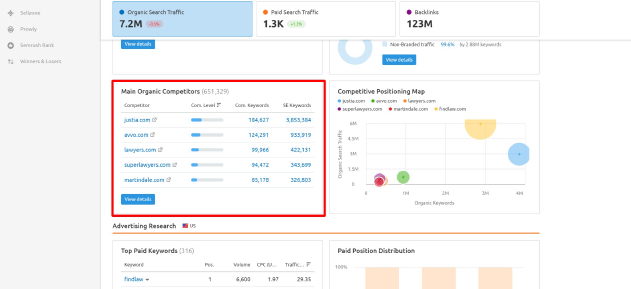
2) Find Your Primary Keywords
Once you have identified your top competitors, you can use their keywords to create a list of what you want your site to rank for.
You should also look at the search volume of each keyword, which will help you prioritize your content-planning based on how many visitors would be interested in finding out more information about that topic or service.
How do you know which is the best keyword?
It's the one that represents the most popular way of searching for the topic.
For example, let's say you were writing a post about the best law firm in New York. There are a lot of ways people could search for this, such as:
- what is the best law firm in New York
- best lawyers in New York
- NYC law firms
So which one of these keywords do you target?
Whichever permutation of the search that has the highest search volume.
In addition to SEMRush, you can search for your topic in Ahrefs' Keywords Explorer and search for the Parent Topic.

3) Discover Long-Tail Keywords Variations
Instead of just focusing on head terms, it's important to also include long-tail keywords in order for your SEO strategy to be successful.
These less common, but relevant search terms will help drive more traffic and better conversion rates because they offer a higher degree of targeting than traditional searches do.
Long-tail keywords are phrases that people type into Google when they want to find information on a specific topic.
For example, if you were creating a page about the best personal injury law firm in New York, your instinct would be to write on "personal injury lawyer in New York." While the search volume might be high, so is the competition.
One long-tail variation that might be a good term is "Walmart slip and fall personal injury lawyer in New York." The longer, more descriptive keywords typically have less volume, but also much less competition.
4) Create a Keyword Map
A keyword map is a spreadsheet that lists all of your target keywords, along with each keyword's monthly search volume.
You can use this to help prioritize the long-tail keywords you have discovered for inclusion into your content-planning phase.
5) Analyze the Intent of Pages that Rank
The intent of pages that rank for a keyword typically fall into two categories: information or purchase intent.
Let's say you see that many people are searching for "Cleveland criminal defense lawyer." You can now enter this into Google and view pages that are currently ranking for this keyword.
If Google has mostly sales pages that rank for that keyword, then you should create a sales page to target that keyword. But if Google shows that blog posts discussing the topic show first in the search results, then you should target the keyword with an article about the topic.
6) Identify Question Keywords
Question keywords are specific types of long-tail searches that represent questions people enter into Google.
For example, a question keyword that relates to personal injury law firms might be "how much does a personal injury lawyer cost?"
The more related topics that your site ranks for, the more Google will trust your site to rank you for the parent term, "personal injury lawyer."
You can also use the Semrush keyword overview tool to find a list of questions that match to any keyword entered. It allows you to see the monthly search volume of these question keywords.
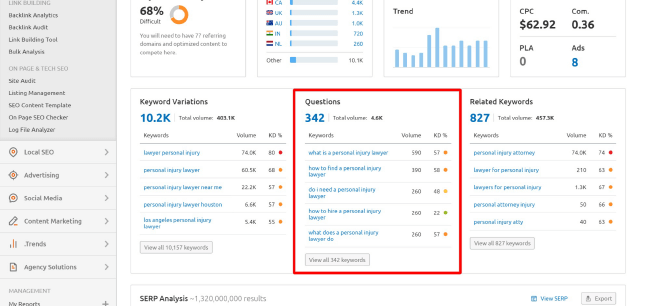
7) Prioritize by Search Volume and Keyword Difficulty
Once you've created your list of keywords to target, you're ready to start prioritizing.
You can do this by looking at both monthly search volume and keyword difficulty. Keyword difficulty is calculated using a scale from 0 to 100, with higher numbers representing more difficult keywords.
You want to prioritize the keywords that have both high search volume and low difficulty scores. Again, long tail keywords typically have lower search volume, but also lower competition.
This list of keywords you are looking to target becomes the list of pages you will create. Create a content schedule of what pages you plan on creating and hold to that schedule.
Technical SEO Checklist
Technical SEO refers to a set of rules and best practices that focus on helping search engines crawl, index, and understand your website's content as best as possible. Below are each of the Technical SEO items you should check to ensure your law firm's website is following best practices.
1) Find and Fix Crawl Errors
To quickly identify any crawl errors that exist, head to the coverage report in Google Search Console. You'll see both excluded pages and those with warnings and those that are valid.
Fix the crawl errors that are causing issues and explore causes of excluded URLs.
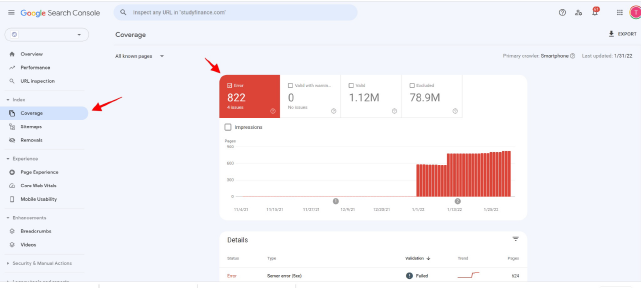
2) Make Sure Your SSL Certificate is Installed Properly
You can easily check if your website's SSL certificate was installed correctly and working properly by looking for certain indicators.
For example, the padlock icon should be available in your URL bar. Also, ensure that there are no errors or warnings upon connecting through your domain.
To have these indicators boosting up your visitors' confidence, you need to install a validated certificate received from the Certificate Authority.
The best option for law firms seeking additional trust is the Positive SSL with Extended Validation (EV) Plan which gives you a green address bar and tells your website's visitors the impression that your law firm is a registered, legitimate business.
3) Check the Page Depth of your Site
The page depth of your website is the number of clicks that it takes for a search engine to reach all content on your pages.
A healthy site should have a page depth around three or lower. This means that the pages do not go too deep and a search engine can easily reach all of your important content from one page.
Good: https://www.example.com/category/sub-category/page
Bad: https://www.example.com/category/sub-category/page/sub-page-1/sub-page-2
If your site's content requires more than 3 levels, consider using a subdomain for a portion of your site's content.
4) Check for Duplicate Versions of Your Site in Google's Index
Visitors to your website should only be able to visit it at one location. This will help with crawling, indexing and security issues that could arise from having multiple sites running on the same server.
Plug these four URL formats, substituting your own domain, into httpstatus.io to check that everything is in order:
- http://yourdomain.com
- http://www.yourdomain.com
- https://yourdomain.com
- https://www.yourdomain.com
If everything is working properly, then three of them should redirect to the fourth.
If it doesn't work, set up a permanent 301 redirect.
5) Ensure Your Website is Mobile-Friendly
There are various tools you can use to check whether or not your site is mobile-friendly, including Google Search Console and the Google Mobile-Friendly Test.
If your website isn't very mobile friendly, then you should work towards making it more user-friendly for people who visit your site on their phone.
This will help to improve your rankings and increase the number of people who visit your site.
6) Ensure Cloudflare is Enabled to Reduce Load Times
Websites that experience high traffic may lose millions for every second spent on load time.
Cloudflare uses reverse proxies to reduce the number of requests being sent to your server. It also helps with security, making it easier for search engines to crawl your site.
101domain's Secure Web Accelerator Plus is encouraged for sites looking for extra speed and security. The plan offers Content Delivery Network (CDN) and automatic static content caching that boost website speed and decreases page load times by caching content in multiple locations around the world.
7) Leverage "Inspect URL" Feature in GSC
The "Inspect URL" feature in Google Search Console can help you see a specific URL's HTTP response code, the page resources, the JavaScript logs and a rendered screenshot.
The tool will show you what Google bots see when they crawl and render your page.
It can pinpoint any issues with coding or other things that might be preventing them from properly processing the information on it, so you have an opportunity to fix those problems before their site gets ranked.
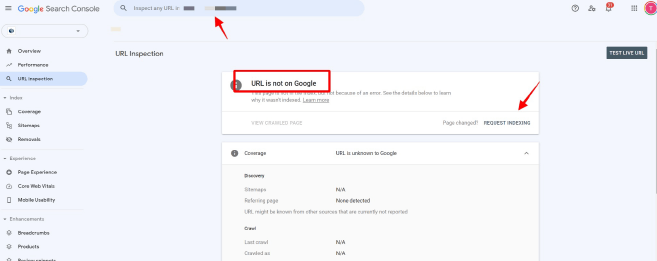
8) Fix Broken Internal and Outbound Links
Broken internal and outbound links are the biggest technical issue that can affect user experience. You don't want your users to click on a link and find that it takes them nowhere.
If you see any broken internal or outbound links in the Site Audit report, you need to fix these issues by updating target URL as needed before anyone else gets stuck.
9) Use an SEO-Friendly URL Structure
A URL structure that is SEO-friendly will help the crawlers in the search engines to better index your site and know what you're talking about in your content.
It also helps with readability and user experience to have meaningful URLs that are easy for users to understand.
Here's an example of an SEO-Friendly URL Structure: https://www.example.com/new-york-city/
Here's a poor example: https://www.example.com/d9q_fy-law-page-1
10) Find and Fix HTTP Links on HTTPS Pages
Just because your site is secure (HTTPS) doesn't mean the pages you link out to are secure.
Be sure that all pages you link out to are secure and free from malware.
You can export all of the outbound links on your site using a tool like Ahrefs:
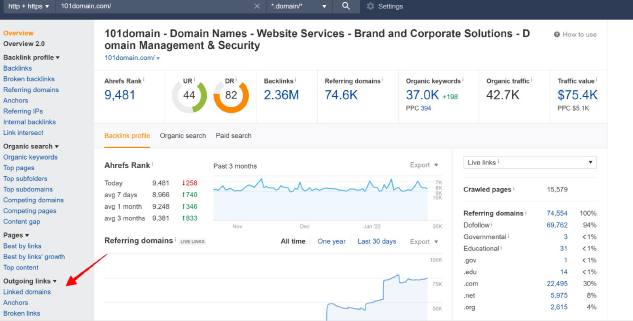
11) Add Structured Data (Schema Markup)
Structured data markup is a standardized format that allows search engines to better understand the information on your site.
You can add rich snippets and structured data markup in HTML using Schema.org, and this will help you show up with review stars next to your search result listing when people are searching for a law firm in your area.
Some of the best and most common schema markups include:
- FAQs
- Reviews
- Breadcrumbs
- Organization name
- Author (if article)
- Image
- Video

12) Check Canonical Tags
Both search engines and users can use canonical tags to address duplicate content issues.
You can set canonical URLs to point to the original content which will solve the duplicate content issues and help your search rankings.
Google and other search engines give you a chance to specify that particular version of your site they should consider as the authoritative one, which is why it's important to check for any possible issues with canonical tags on your site.
On-Page SEO and Content Checklist
Mapping your pages to keywords is important, but that alone does not fully optimize a page. Below is an on-page SEO and content checklist to improve your pages' rankings.
1) Find and Fix Duplicate, Missing, or Truncated Title Tags
In order for Google to understand your content, you need to have a proper title tag.
You should check your site's title tags and make sure they are as descriptive as possible. This will help people to click on your site exactly when they're searching for it.
SEO title tags are limited to 600 pixels (about 60 characters). A good title should use as many pixels as possible without going over since this will cause the title to become truncated.
Also, make sure that there are no missing title tags on your pages, as this could potentially affect your ranking.
Example of a truncated title that is too long:

2) Find and Fix Duplicate, Missing, or Truncated Meta Descriptions
It's important to check and fix your pages' meta descriptions and make sure that they're unique on each page. Meta descriptions are limited to 160 characters; any longer than that will become truncated in the Google Search results.
Just like with titles, descriptive meta descriptions help people to understand what your content is about and understand if it's something worth reading or not.
3) Find and Fix Multiple H1 Tags
Using multiple H1 tags on one single web page is considered poor SEO practice because each page should be about 1 topic. It is better to use Heading 2 (H2) tags for different sections of your content.
Multiple H1 tags are not uncommon, especially if your site's logo or main heading is wrapped in one. The purpose of H1 tags should include the page's target keyword so be sure you're wrapping the right content with your H1 tag.
4) Improve Title & Meta Description Tags
As mentioned above, good title tags typically max out the length allowed without going over.
In addition to length, a good title and meta description have the following elements:
- include the keyword in a natural way
- be descriptive of the page
- match the search intent of the user
- be interesting, but not misleading
- contain a call to action
- may contain your law firm's name
You should also check your heading tags and make sure they are unique for each page.
To get an idea of what Google thinks your page is about, look at your performance report in Google Search Console and identify keywords on each page that have been receiving the most impressions:
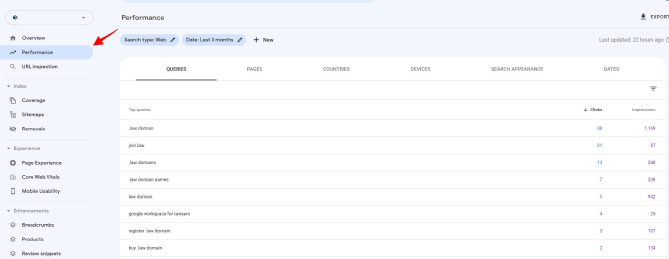
5) Run a Content Audit and Prune Content
Thin or short content should be removed and redirected to a different page using a 301 redirect.
You can always identify pages on your site that aren't as successful as others. Look into their content and try to find out why these particular articles are receiving less traffic compared to others.
These pages might be ranking for unrelated keywords or they simply aren't properly optimized to target the right audience.
6) Ensure Images Use ALT Tags
Google can't "see" what your images are about. Because of that, you should always add ALT attributes to your pictures describing what they're all about in addition to a helpful image title and file name.
ALT tags are also used by screen readers for visually impaired people, which is another great reason to utilize them.
7) Improve Internal Linking
An internal link is when one page on your website links to another page on the same domain.
When you're writing new content, it's important to consider what other related pages your visitors might be interested in. Your article will likely reference topics that you have written about before.
You should identify the best internal linking opportunities and use them so that relevant content would find its way to more relevant audiences.
8) Find and Fix Keyword Cannibalization
When you have multiple pages targeting the same keywords, it becomes very hard for search engines to determine which page deserves to be ranked higher.
This is because if similar or duplicate content exists on more than one URL, Google will only use one of them and it may not be the right fit for your site's context.
In order to keep your website safe from "cannibalization," identify the pages on your site that are targeting the same keywords. Then remove and redirect cannibalized pages by creating 301 redirects.
9) Update Outdated Content
You should regularly audit your content and remove or update outdated content.
Take a look at pages that are receiving no or very few searches (less than 10 every month according to Google Analytics). These are good candidates for updates.
Pages may have your firm's old address or may contain out-of-date information.
Google looks at "content freshness" to evaluate whether a page is relevant to a particular user's search.
10) Improve Content Readability
Webmasters should ensure that the site's content is easy to read. This is both in how the content is worded and in how it is presented.
Below are a few ways to improve readability:
- write shorter paragraphs
- use larger margins
- use a clear and readable font (rather than a fancy font)
- use a large font size (typically 20px or more)
- use clear headings and subheadings
- use bullet points and lists where appropriate
- check your content for grammar errors and typos
- make sure site is mobile friendly
Off-Page SEO Checklist
Link building is a tedious, but necessary task for any SEO campaign. It has been confirmed by Google that backlinks are one of their "top 3" ranking signals, so without links your site will not rank well.
In this section we cover some tried and true link building strategies.
1) Analyze your Competitor's Link Profile
You can learn a lot about proper link building and what results in good backlinks by reviewing your competitors' profiles.
Use a tool like Ahrefs to uncover their best performing content, target keywords, types of backlinks they are getting, etc.
2) Conduct a Link Intersect Analysis
The backlink analytics tool can help you find quick-win opportunities by showing which domains are linking to your competitors.
For example, if there is a resource page on another website that doesn't mention yours but has links from other sites in their portfolios, then reaching out might be an effective way for your site to be added.
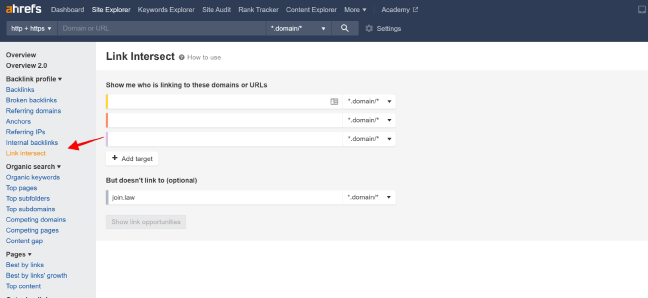
3) Steal your Competitors' Broken Backlinks
It is common practice for websites to link out to broken URLs.
You can use SEO tools like Ahrefs and SEMRush to find instances of links to pages that are "broken" or result in a 404 error.
If you have a resource that matches the broken resource being linked to, reach out to the website owner to swap out the link.
Use tools like hunter.io to find the emails associated with the website.
4) Leverage Digital PR to Form Relationships with Influencers
Digital PR is the process of creating and maintaining valuable relationships with influencers in your industry.
Law firms can find high-quality prospects by searching Google for law industry related associations, law firm web pages, law blog directories, law student organizations etc.
You can use HARO (Help a Reporter Out) to find outlets looking for quotes from attorneys who will often link back to the law firm's website.
5) Implement the Skyscraper Technique
The Skyscraper technique is where you build an even better resource than what exists (a taller skyscraper) and ask websites linking to the current resource to instead link to yours.
The steps for the Skyscraper technique are:
- identify content that has been getting a lot of links from other sites
- create an even better resource than what exists
- use Hunter to find the contact information of the websites linking to the existing resource
- ask webmasters to instead link to your (better) resource
Doing this can help you build an authority site that brings in links, social shares and traffic.
6) Turn Unlinked Mentions into Links
If people are mentioning your law firm in articles, interviews or podcasts without linking to you then there is a good chance that these mentions can be turned into links.
You need to track down the source of the mention and let them know that they don't have a link back to your law page. A polite email asking for this should do the trick.
Conclusion
The legal space is a competitive industry, but with the help of this SEO checklist, you now have the essential steps to take to make your firm's site rank higher on Google.
101domain is the legal industry's trusted partner, with more .law domains under our management than any other domain registrar.
If you need help finding the right domain, improving page speeds and security by implementing our Secure Web Accelerator powered by Cloudflare, or have any questions as you navigate the digital space, don't hesitate to contact one of our account executives for assistance.
Frequently Asked SEO Questions
1) How long will it take to rank once I start SEO for my law firm?
Depending on the amount of work your website requires and how often search engine spiders crawl it, you can expect to see new rankings 6-12 months after launch.
You can see some increased traffic within the first few months, but typically major improvements come one full year after implementing best practices.
2) Why should I continue SEO once I've gotten good rankings?
You should continue SEO because Google is always changing its algorithms. Keywords can become more competitive over time and your content can become irrelevant, so law firms need to keep updating their law site with fresh content and build new backlinks in order to maintain or improve rankings.
3) Can't we just buy links?
No. It's important to remember that buying links can get you penalized or even kicked out of Google search results altogether. This is why it's crucial to avoid this practice and start doing the work needed on your law firm's website to naturally gain authority within search engines. View all of Google's link schemes here.
4) How much should I pay an SEO agency to do SEO for my website?
Like most things in life, you often pay for what you get. For a typical contract with an SEO agency, you can expect to pay $2k-$5k per month.
If you are outsourcing a lot of work to the agency (such as creating the content or aggressively building links), it's not uncommon to have a $10k+ per month contract.
